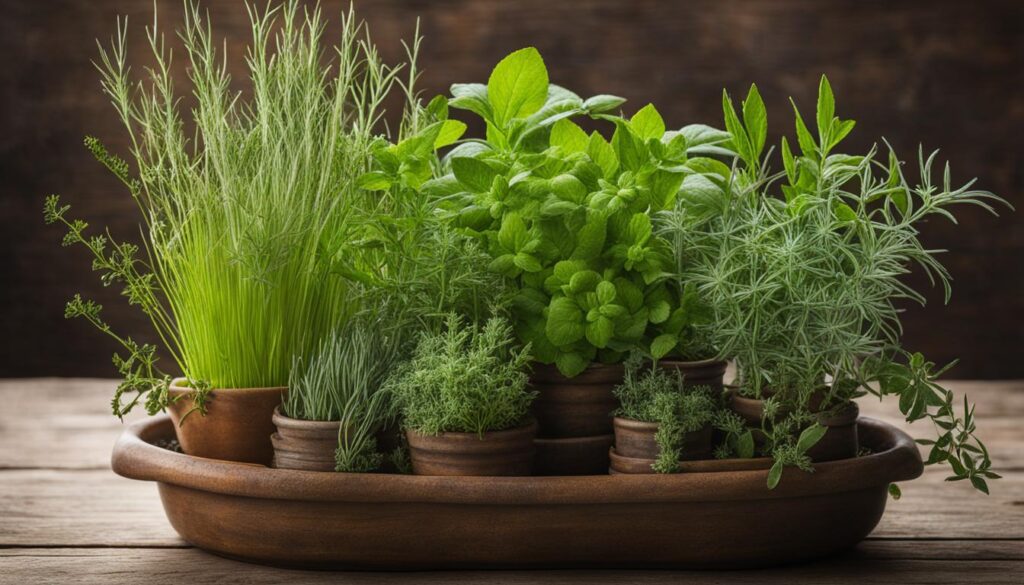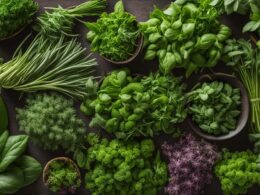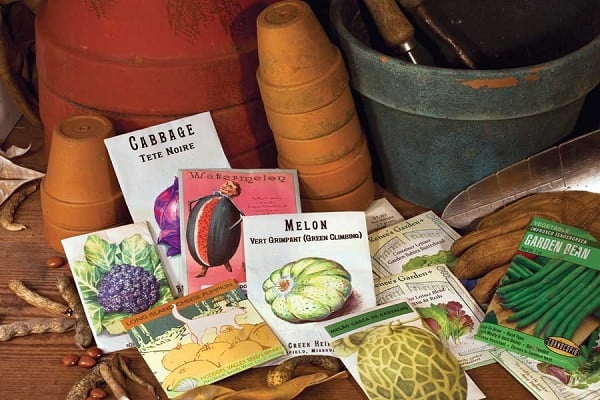Are you interested in herb gardening but have limited space? Wondering if you can plant different herbs together in the same pot? The answer is yes! Not only can you save space with a space-saving herb garden, but companion planting herbs in the same container can also benefit the plants’ health. In this article, we will explore the advantages of planting different herbs together, the herbs that can be planted in the same pot, and how to care for them.
Companion planting herbs in the same pot offers several advantages. It allows you to maximize your gardening space, making it ideal for those with limited outdoor areas. Additionally, planting different herbs together creates a mini-ecosystem where they help each other grow. This can help reduce the spread of diseases and improve moisture retention in the soil. Understanding your local gardening climate and the specific needs of each herb will help you determine which combinations will thrive in the same pot.
Key Takeaways:
- Planting different herbs together in the same pot can save space and benefit the plants’ health.
- Companion planting creates a mini-ecosystem, reducing disease spread and improving moisture retention.
- Choose herbs with similar growing needs and consider your culinary preferences when selecting herb combinations.
- Growing herbs in containers is a convenient way to have fresh herbs close to your kitchen.
- Transplant herbs from the garden to pots for an indoor herb garden during freezing weather.
Benefits of Companion Planting Herbs Together
Companion planting herbs in the same pot offers a multitude of benefits. Firstly, it allows you to maximize your gardening space, making it an excellent option for those with limited outdoor areas. By combining different herbs in one container, you can create a harmonious mini-ecosystem where they support and promote each other’s growth.
Another advantage of companion planting is improved moisture retention in the soil. When herbs are planted together, they create a natural barrier that helps to slow down water evaporation, reducing the frequency of watering. This not only saves you time and effort but also conserves water.
Planting different herbs together can also have a positive impact on their health and flavor. Many gardeners have noticed that certain combinations of herbs grown together can enhance the overall taste and aroma of their dishes.
To capitalize on the benefits of companion planting, make sure to select herbs with similar growing requirements. Consider factors such as light exposure, water needs, and soil nutrition. This will ensure that each herb in the pot thrives and contributes to the overall success of your herb garden.
Herbs That Can be Planted Together
When it comes to companion planting herbs, the options are endless. By carefully selecting the right combinations, you can create a harmonious herb garden that not only saves space but also enhances the growth and flavor of your plants. Here are some examples of herbs that can be planted together:
- Basil, parsley, and oregano are popular herbs that can thrive together in the same pot. They all have similar growing requirements and add brightness and depth to a variety of dishes.
- Mint herbs, such as peppermint and spearmint, are best planted separately or with other varieties of mint. Their invasive nature makes it important to keep them contained.
- For hot climates, consider planting warm-season herbs like basil, oregano, and sage together. These herbs thrive in the summer heat and can be enjoyed in a multitude of culinary creations.
- In mild to cool climates, you can mix and match a variety of herbs in one container. For example, combine rosemary, thyme, and lavender to create a beautiful, aromatic display.
Remember to consider the specific needs of each herb in terms of moisture, sunlight, and drainage. Some herbs, like basil, parsley, and lemon balm, prefer moist soil, while Mediterranean herbs like rosemary, thyme, and lavender thrive in drier conditions. By understanding the unique requirements of each herb, you can create a successful and visually appealing herb garden.
Companion Planting for Optimal Results
Companion planting herbs is not just about aesthetics and convenience; it can also provide benefits for your plants’ health and overall growth. When certain herbs are planted together, they can act as natural pest repellents or attract beneficial insects that help control pests.
Including herbs like rosemary, sage, and thyme in your herb garden can deter pests like cabbage moths and carrot flies. These herbs have natural oils and fragrances that repel insects, making them valuable companions for other herbs.
Additionally, planting herbs with similar growth habits can help create a mini-ecosystem where they support and nourish each other. For example, the deep taproots of dill can help break up compacted soil, benefiting nearby shallow-rooted herbs like basil. By understanding the synergistic relationships between different herbs, you can maximize the health and productivity of your herb garden.
Explore different combinations of herbs and experiment with various companion planting techniques to find what works best for your specific gardening conditions. With a bit of careful planning and consideration, you can create a thriving herb garden that not only saves space but also adds beauty and flavor to your culinary adventures.
Moisture-Loving and Mediterranean Herbs
When it comes to planting herbs together in the same pot, it is important to consider their specific needs. Some herbs thrive in moist conditions, while others prefer a drier environment. By understanding the moisture requirements of different herbs, you can create a harmonious herb garden that promotes healthy growth and maximizes the flavor of your dishes.
Herbs That Like Water
Moisture-loving herbs, such as basil, parsley, and lemon balm, are perfect for those who enjoy cooking with fresh ingredients. These herbs thrive under full sun conditions and require moist, well-drained soil. To ensure their success, make sure to provide proper spacing between plants and choose a potting mix that retains moisture without becoming waterlogged.
“Moisture-loving herbs, such as basil, parsley, and lemon balm, are perfect for those who enjoy cooking with fresh ingredients.”
Mediterranean Herbs
On the other side of the spectrum are Mediterranean herbs, such as rosemary, cilantro, thyme, oregano, sage, chives, dill, and lavender. These herbs are accustomed to sunny and drier conditions, making them excellent choices for gardeners in warmer climates. They thrive in well-drained soil and require a potting mix that is rich, dark, and crumbly. Allow the soil to dry between waterings to prevent overwatering, which can lead to root rot and other plant health issues.
“Mediterranean herbs, such as rosemary, cilantro, thyme, oregano, sage, chives, dill, and lavender, thrive in sunny and drier conditions.”
By grouping moisture-loving herbs and Mediterranean herbs together in separate pots, you can ensure that each herb receives the ideal growing conditions for their specific needs. This practice allows you to create a diverse and thriving herb garden that caters to a variety of culinary preferences.
Planting Herbs Based on Culinary Preferences
When it comes to planting herbs in your garden, considering your culinary preferences is key. Choosing the right combination of herbs can enhance the flavors of your dishes and make cooking a truly enjoyable experience.
If you love pasta dishes, planting herbs like basil, parsley, and oregano together is a perfect choice. These aromatic herbs not only add freshness to your recipes but also complement each other in flavor. Imagine the vibrant taste of a homemade marinara sauce infused with freshly picked basil leaves and a sprinkle of chopped parsley.
For those who enjoy meat dishes, rosemary, thyme, and oregano are excellent options. These herbs add depth and fragrance to roasted or grilled meats. Sprinkle some chopped rosemary and thyme over a juicy steak, or add a pinch of oregano to your meatball mix for a burst of savory goodness.
While selecting herbs based on culinary preferences is essential, it’s equally important to ensure they have similar growing requirements. Make sure all the herbs you choose for your herb garden require the same amount of light, water, and soil nutrition to thrive together. If the needs differ significantly, it may be necessary to plant them in separate pots.
Growing Tips:
- Plant basil, parsley, and oregano together for delicious pasta dishes.
- Combine rosemary, thyme, and oregano to infuse meat dishes with flavor.
- Ensure that herbs with different growing requirements are planted in separate pots.
“Pairing the right herbs in your garden can elevate your cooking to new heights.”
Growing Herbs in Containers
Growing herbs in containers is a popular option for those with limited outdoor space or for anyone who wants the convenience of having fresh herbs close to their kitchen. Container gardening offers several benefits, making it a practical and rewarding choice for small-space herb gardening.
“Container gardening allows you to make the most of small spaces, such as balconies or patios, and provides the convenience of having fresh herbs close to your kitchen.”
One of the major advantages of container gardening is its space-saving nature. You can create a thriving herb garden even in the tiniest of areas by using pots, planters, or hanging baskets. Vertical gardening techniques, such as using strawberry jars or tiered planters, maximize space and create an attractive herb garden. These options not only add aesthetic appeal to your space but also allow you to grow a wide variety of herbs.
Another benefit of growing herbs in containers is the flexibility it offers. Containers can be easily moved to different locations, allowing you to optimize sunlight exposure for your herbs throughout the day. This is particularly useful in areas where sunlight is limited or when you need to protect the plants from extreme weather conditions. Additionally, container gardening allows for easy maintenance and reduces the risk of soil-borne diseases.
For those who wish to enjoy fresh herbs year-round, indoor herb gardens are a great solution. By transplanting your outdoor herbs to pots and bringing them indoors before freezing weather arrives, you can continue to enjoy fresh flavors and aromatic herbs even during colder months.
Benefits of Growing Herbs in Containers:
- Space-saving option for small areas like balconies or patios
- Flexibility to optimize sunlight exposure
- Easy maintenance and reduced risk of soil-borne diseases
- Possibility of year-round herb gardening with indoor containers
Conclusion
Growing different herbs in the same pot is a convenient and space-saving method of herb gardening. By ensuring that the herbs have the same growing season and similar light, water, and nutrient requirements, you can create a thriving mini-ecosystem in a single container. Companion planting herbs together not only saves space but also offers additional benefits, such as improved moisture retention and reduced disease spread.
Understanding your local gardening climate and the specific needs of each herb is essential in determining which combinations will thrive in the same pot. Consider your culinary preferences when choosing herbs for planting. Basil, parsley, and oregano make great companions for pasta dishes, while rosemary, thyme, and oregano are ideal for flavoring meat dishes. By selecting herbs that you enjoy cooking with, you can enhance the flavors of your dishes and make the most of your space.
Whether you have a small urban area or a larger garden, planting herbs together can be a rewarding and convenient way to enjoy fresh herbs throughout the year. With proper care and attention, your herb garden will flourish and provide you with an abundant supply of herbs for all your culinary needs. So go ahead and start planting your favorite herb combinations in the same pot—enjoy the benefits of a thriving herb garden right at your fingertips!
What Herbs Can Be Planted Together in the Same Pot?
When planting multiple herbs in one pot, it’s important to choose ones that have similar growing requirements. Herbs like basil, oregano, and thyme can be planted together as they all thrive in well-draining soil and full sun. This allows them to coexist and flourish in the same container.
FAQ
Can I plant different herbs in the same pot?
Yes, you can plant multiple types of herbs together in one container as long as they have the same growing season, light and water requirements, and nutrition needs.
What are the benefits of companion planting herbs together?
Companion planting herbs in the same pot not only saves space but can also benefit the plants’ health by creating a mini-ecosystem where they help each other grow to their full potential. Planting different herbs together can also help reduce disease spread and improve moisture retention in the soil.
Which herbs can be planted together?
The herbs that can be planted together in the same pot depend on their growing season and specific needs. Examples include basil, parsley, and oregano in mild to cool climates, and basil, oregano, and sage in hot climates.
What are moisture-loving and Mediterranean herbs?
Moisture-loving herbs, such as basil, parsley, and lemon balm, prefer full sun conditions and require moist but not waterlogged soil. Mediterranean herbs, such as rosemary, thyme, and lavender, thrive in lots of sunlight and generally drier soil.
Can I plant herbs based on my culinary preferences?
When deciding which herbs to plant together, consider your culinary preferences. Basil, parsley, and oregano are popular choices for pasta dishes, while rosemary, thyme, and oregano are great for flavoring meat dishes.
What are the benefits of growing herbs in containers?
Growing herbs in containers allows you to make the most of small spaces, provides the convenience of having fresh herbs close to your kitchen, and allows for easy movement of plants without disturbing their roots.
Can you summarize the advantages of planting herbs together?
Planting different herbs in the same pot is possible as long as they share the same growing season and have similar light, water, and nutrient requirements. Companion planting herbs in a container saves space, improves moisture retention, reduces disease spread, and can enhance flavor.











